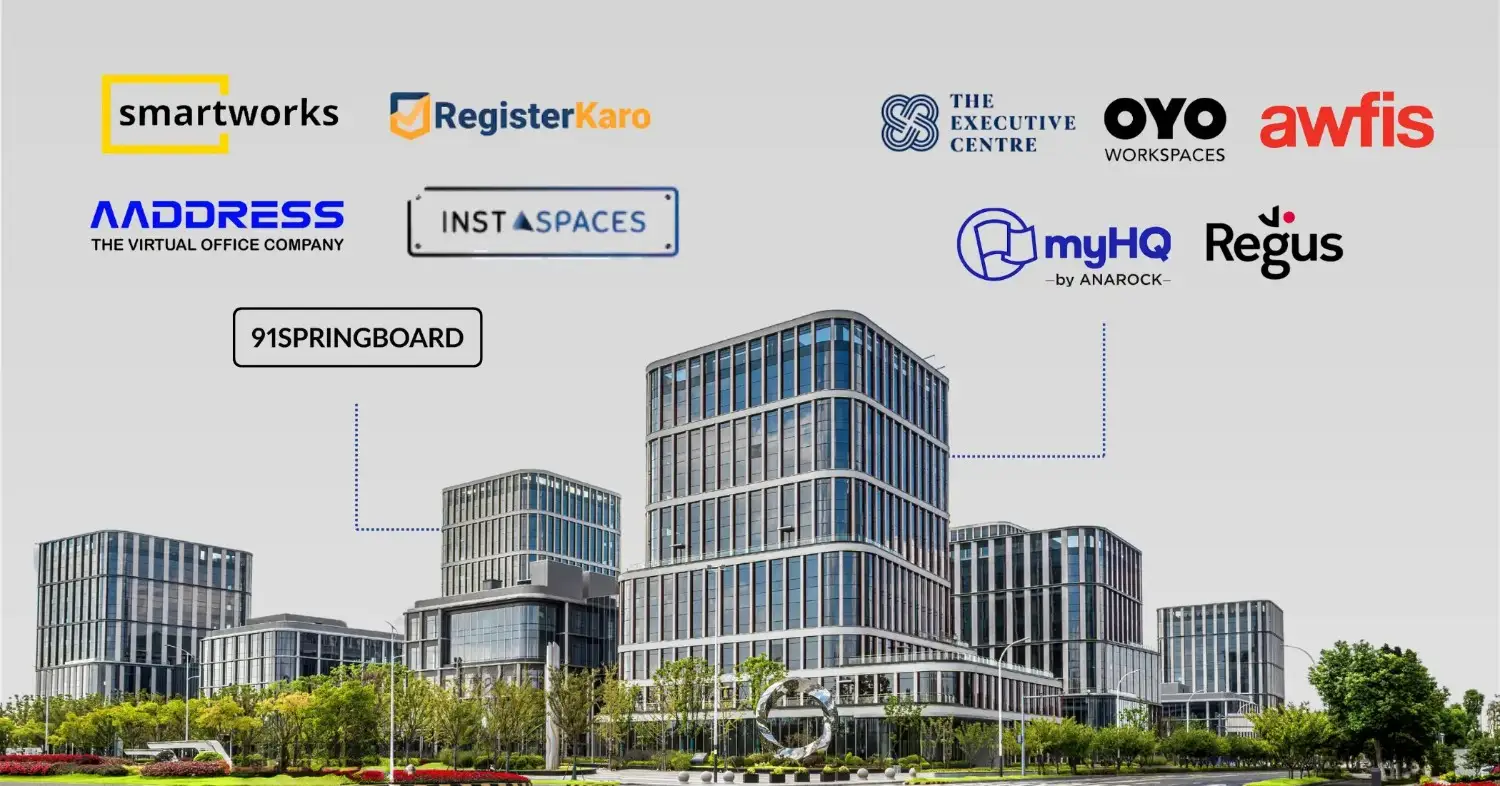
Is your office rent a monster? Does it swallow all your profit with high rental and electricity costs? If that’s the case, then you are lagging. Why? Because the traditional way of working is dead. The modern business landscape demands flexibility, which comes with establishing a virtual office space.
The COVID-19 pandemic made virtual offices a necessity, but now they are becoming a popular choice for many workplaces. The growth of the gig economy has also increased the use of virtual offices, as businesses see the cost savings they provide.
If you run an LLP or a private limited company, you face an important decision like many other entrepreneurs. You must choose the right setup. In this blog, we are settling the ultimate debate: Virtual Office vs Traditional Office. Find out the pros and cons of both business styles in detail.
Virtual Office and Physical Address: Basic Difference
The core conflict is simple. It’s the physical office vs virtual office. Let’s first establish the difference between a virtual address and a physical address.
Virtual Office
A virtual office allows businesses to work remotely while still handling office tasks. This setup gives you the flexibility to operate without the need for a traditional office lease. In a virtual office setup, employees have access to teleconferencing, online meeting spaces, and message reception services.
The use of “virtual offices” or “home offices” is becoming increasingly prevalent, especially among small and startup firms. This trend has been expedited by the integration of video-conferencing capabilities into various messaging platforms and software.
Traditional Office
This is a brick-and-mortar building. It is a fixed, tangible location. You sign a long lease. You pay high bills. This is the classic, old-school office setup that stands as one of the numerous workspaces functioning as the core hub of an organizational setup. Despite the growing popularity of virtual workplaces, many businesses still opt for the stability of a tangible location. This decision often depends on factors like the type of business, the company culture, and the resources available.
Advantages and Disadvantages of a Virtual Office
The traditional office vs the modern office is a stark choice. Sticking to the old way is costly, whereas the virtual office address brings multiple benefits:
Advantages of Virtual Office
Here are the top benefits of going ahead with a virtual office space:
- Cost Savings: Opting for a virtual office translates into lower overhead costs, as companies can bypass the expenses associated with traditional office spaces. This cost-effective approach allows businesses to redirect capital towards the effective management and promotion of their ventures.
- Reduced Workplace Conflicts: The prevalence of online chat and video conferencing applications in virtual offices minimizes typical office drama. This results in a more harmonious work environment compared to conventional workplaces, proving to be a significant advantage.
- Streamlined Management: Virtual offices streamline administrative tasks, reducing the need for extensive management. This, in turn, leads to a decrease in administrative expenses for businesses that choose this modern approach.
- Enhanced Productivity: Workers in virtual offices often experience increased productivity, thanks to the elimination of commute times. With the flexibility to work from anywhere with internet access, employees can accomplish more in less time.
- Flexibility: The absence of physical constraints allows workers the freedom to choose when and where they work, provided they meet their job requirements. This flexibility is a valuable asset for individuals seeking a better work-life balance.
- Effortless Expansion: Companies utilizing virtual offices find expansion more accessible, as they are not tied to the constraints of Traditional Office spaces. This flexibility enables organizations to grow their operations seamlessly.
Disadvantages of Virtual Office
The virtual office space also has some considerable negative aspects, which shouldn’t be ignored:
- Lack of Physical Workspace: While many businesses can thrive without a Traditional Office, certain work settings may necessitate a tangible space. This limitation can be a drawback for industries requiring a physical presence.
- Structural Challenges: Conducting business through virtual offices demands a well-defined structure and adherence to established rules. The absence of such a structure can potentially impact worker output negatively.
- Diminished Connectivity: Virtual offices contribute to a reduction in face-to-face interactions among employees, affecting the sense of community within the workforce. To counteract this, businesses should cultivate a culture that fosters connectivity and stronger interpersonal relationships.
- Distractions: Operating in virtual workplaces may expose individuals to more distractions, particularly when working from unconventional settings like home or local coffee shops. This heightened potential for distraction can lead to a decline in overall productivity.
- EASY Multi-State GST Registration: A Virtual Office allows you to legally register for a GSTIN in multiple states using one service provider, eliminating the huge cost and hassle of renting separate physical offices across the country for tax compliance.
Read Also: Virtual Office Cost in India
Advantages and Disadvantages of a Traditional Office
A Traditional Office provides a dedicated, physical space for businesses. Its key advantage is the built-in professionalism and control. You foster stronger team bonds through daily face-to-face interaction. However, this setup comes with major downsides. It requires expensive long-term leases, high overhead costs, and maintenance fees.
Advantages of Modern Office
Below are listed the top benefits of going ahead with a traditional office setup:
- Credibility and Professionalism: A Traditional Office adds credibility and professionalism to a firm by providing a space for customer meetings and other business interactions. Establishing a physical presence fosters a sense of community between businesses and their clients.
- Management Authority: Companies with their own office buildings have greater control over workplace conditions. Establishing a business culture and hierarchy becomes more manageable.
- Facilitates Interaction: A shared workspace in a Traditional Office facilitates easier interaction and collaboration among employees.
- Performance Visibility: It is easier to assess how well employees are executing their tasks within a Traditional Office setting.
- Communication Improvement: The Traditional Office environment aids staff in enhancing their communication abilities.
Disadvantages of Modern Office
Every coin has two sides, and so do modern office settings, too. Let’s have a look at its disadvantages:
- Costly Undertaking: Maintaining a Traditional Office can be an expensive endeavor, encompassing office leases, furnishings, supplies, technology, and other operational expenses.
- Geographic Restrictions: Companies are constrained in hiring employees outside a specific geographic region. This limits access to a global pool of skilled potential employees.
- Productivity Challenges: Lengthy commutes can potentially lead to decreased employee productivity.
Distinguishing Traditional and Virtual Offices
The main distinction lies in the physical space and cost structure. The choice is fundamentally between the stability of a physical address versus the agility and affordability of a virtual address.
- Physical Meeting Spaces: Virtual offices lack consistent access to Traditional Office spaces. Employees often work remotely, necessitating meetings at various locations or shared spaces provided by virtual office providers. While this flexibility enhances convenience, effective communication tools become paramount to bridge the gap.
- Overhead: Virtual offices circumvent expenses associated with leasing physical space, parking, and utilities. This reduction in operating costs provides significant flexibility, especially beneficial for small companies or those with widespread teams.
- Oversight: Traditional offices often measure an employee’s dedication by their physical presence and hours spent at the desk. In contrast, virtual offices emphasize accountability based on results, promoting productivity and efficiency while freeing individuals from the constraints of a traditional 9-5 schedule.
- Convenience and Customer Trust: Virtual offices prioritize convenience, allowing employees to work from anywhere, often from the comfort of their homes. However, the absence of a physical location can impact customer trust. Traditional offices, with a tangible space, foster face-to-face interactions, contributing to customer confidence. Virtual offices often address this by booking spaces for essential in-person interactions.
- Flexibility and Accountability: A significant distinction lies in the work hours of employees. Virtual offices grant unparalleled flexibility, allowing individuals to choose when and where they work. In contrast, traditional offices often adhere to fixed working hours monitored closely by management. The choice between the two depends on one’s preference for control over work hours and the discipline required for remote work.
In summary, the decision between traditional and virtual office settings hinges on the specific needs and priorities of a business. It’s a delicate balance between the convenience and flexibility of virtual offices and the trust-building potential and structured oversight of traditional offices.
Hybrid Model Strategy: The Winning Office Setup
You don’t have to pick a side in the virtual vs physical address battle. The true, unstoppable winner is balance. The modern office doesn’t require an absolute choice. Instead, it demands a smart, flexible solution that captures the best of both office types.
Welcome to the Hybrid Office Model, the definitive future of work.
This strategic setup combines the core strengths of the Virtual Office and Traditional Office into one powerful package:
- For Daily Operations: You leverage the Virtual Office for maximum operational efficiency. Your team works remotely, enjoying flexibility and boosted morale. This keeps your costs razor-thin, protecting your profit margins.
- For Legal Compliance and Trust: You secure a Physical Address (via your Virtual Office provider) for essential functions. This prime address is used for legal registrations, mail handling, and establishing instant credibility with clients.
- For Client Impact: Need to sign a big contract? Book a professional meeting room on demand. You get the impressive physical address meeting space only when you need it, eliminating permanent, wasteful rent.
The Hybrid Model doesn’t just manage the difference between virtual address and physical address—it eliminates it! This strategy gives you the financial agility of a lean startup and the professional presence of a corporate giant, all with virtually zero risk. It’s the smart way to scale.
Conclusion
The choice is clear. The massive cost of a traditional office is unsustainable.
A Virtual Office offers financial freedom and flexibility. It is the definitive difference between virtual and physical address success stories. For modern startups and growing businesses, the virtual office vs traditional office debate has a winner.
Ready to dominate your market? Get your premium Virtual Office Address today with RegisterKaro! Contact Now for more details!
Frequently Asked Questions (FAQs)
Q1. Is a Virtual Address legal for company registration and official use?
A. Absolutely. A virtual address is 100% legal for company registration, government compliance, and receiving official correspondence. Reputable providers give you all the necessary legal documents (like a rental agreement and NOC) to prove your registered business address.
Q2. How much money can I actually save with a Virtual Office?
A. You can save up to 90% on office overhead costs. By paying a small subscription fee for a virtual address instead of thousands in rent, deposits, utility bills, maintenance, and furnishing, your savings are massive and immediate.
Q3. Is a Virtual Office address valid for GST Registration?
A. Yes, it is fully valid for GST registration. The difference between virtual address and physical address doesn’t matter for GST, provided your service provider gives you the mandatory documents (NOC, utility bill, and Rent Agreement) required by the tax authorities to prove the registered physical office vs virtual office location.
Q4. What documentation do I receive for my Virtual Address?
A. To ensure full compliance and validity for your virtual address vs physical address, your provider will give you a Rent Agreement, a No Objection Certificate (NOC) from the property owner, and a recent Utility Bill of the property. These are key for all your legal filings.
Q5. Should my business choose a Virtual Office or a Traditional Office?
A. For almost all modern businesses, the Hybrid Office Model is the best choice. It gives you the cost savings and flexibility of the Virtual Office (for daily work), combined with the professionalism of a Traditional Office (using the address for credibility and booking meeting rooms only when necessary).




